Why is there a crisis in Calais?
- Published
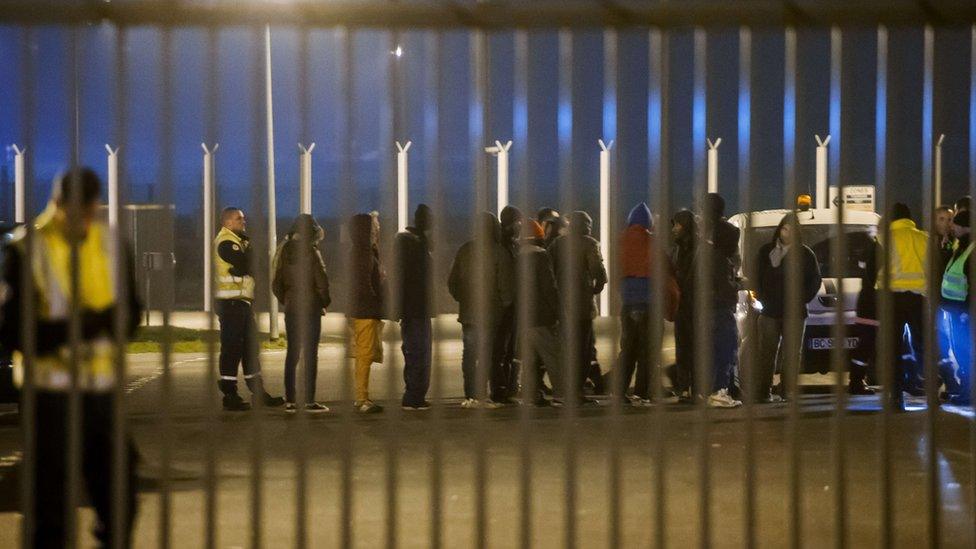
About 100 migrants broke down a fence to enter the Eurotunnel terminal on 3 October
Attempts by migrants to cross the Channel from France into England continue unabated, causing delays and disruption to train services.
In the latest incursion, 100 migrants broke through a fence and entered the Eurotunnel terminal, with some making it into the tunnel itself.
In the same week, a man died near the tunnel entrance in Calais - the 13th migrant to die trying to reach the UK since late June.
But many migrants are undeterred, although the numbers trying to get across the Channel have fallen - in July, some 2,000 migrants a night were trying to get into the terminal, compared to 150 in August.
The migrants, who are living in camps known as "the Jungle" on the edge of Calais, attempt to stow away on lorries headed for Eurotunnel, or jump or cut security fences to try to hide on Eurotunnel trains themselves. They also try to board lorries bound for cross-Channel ferries.
Extra security, including fencing, paid for by the UK, has been put in place.
In August, the UK and France signed an agreement on new measures to help alleviate the crisis, including a new command centre to help tackle the trafficking gangs.
Paul Adams spent one night with some of those who have been trying to gain access to the tunnel again and again

How long has this been going on?
While the scenes of thousands of migrants storming the tunnel over the summer were unprecedented, the issue is far from new. In 1999, the controversial Sangatte refugee camp was opened in Calais, attracting thousands of would-be asylum seekers and people traffickers.
Its closure in 2001 and 2002 - on the orders of France's then minister of the interior, Nicolas Sarkozy - led to riots. Since then migrants have continued to arrive in Calais and build makeshift camps near the port. French authorities estimate there are about 3,000 people currently living in "the Jungle", although other estimates put the number higher.
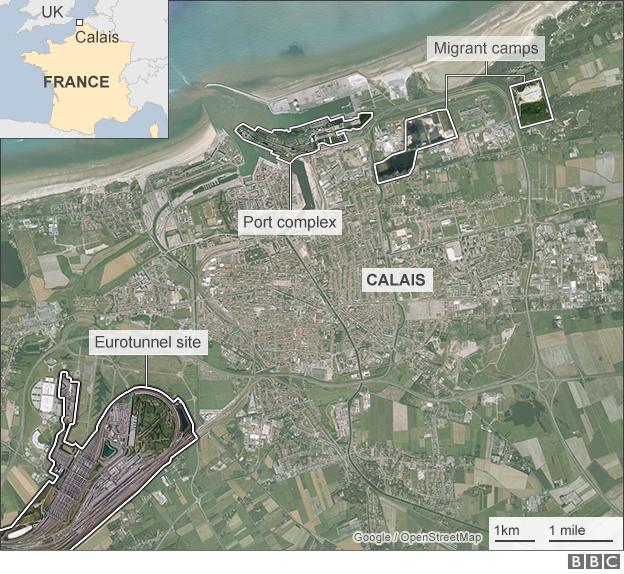
Map showing where the migrants' camp is in relation to the port of Calais and the Eurotunnel site
The issue made headlines again in September last year after a ferry bound for the UK was stormed by about 235 illegal migrants.
The Home Office said the UK Border Force and the French authorities together prevented more than 39,000 attempts to cross the Channel illegally in 2014/15 - more than double the number prevented the previous year, while Eurotunnel, which operates the Channel Tunnel says it has blocked 37,000 attempts since January.

How strong is security in Calais?
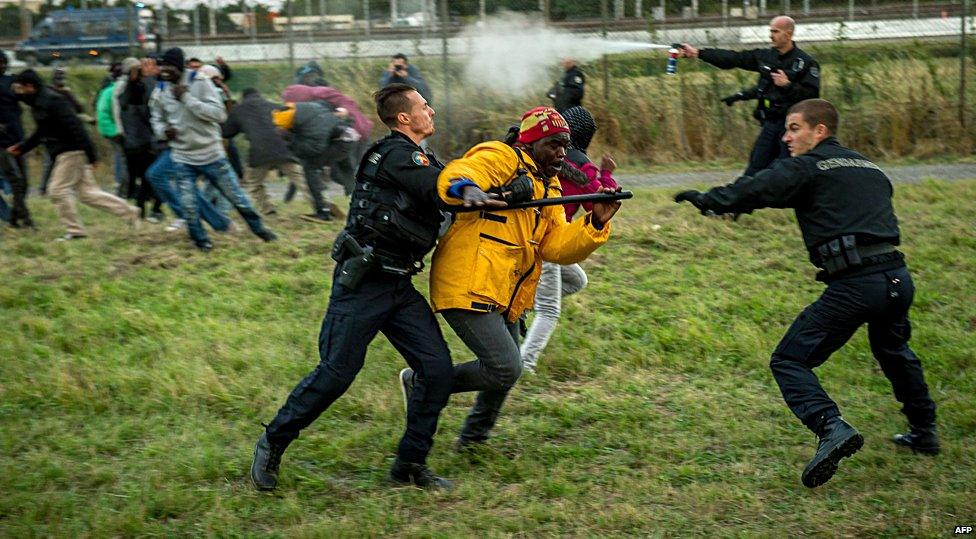
French and UK authorities, and cross-Channel operators, continue to bring in measures to improve security, but migrants are still breaching barriers.
The Calais Chambers of Commerce has responsibility for the security of the port. Last autumn the UK government pledged £12m over three years to help France tackle the problem.
Earlier this month, the UK announced a further £2m for a new secure zone at Calais for UK-bound lorries. It later confirmed it would provide further £7m for measures to improve security at Calais and the entrance to the Channel Tunnel. The UK is also building a fence, known as the "National Barrier Asset", around the terminal at Coquelles.
The port is now protected by 16ft (5m) fences topped with coils of razor wire and CCTV, with the gates and exterior guarded by heavily-armed French riot police.

Eurotunnel has spent £9.2m on security in the first six months of 2015 alone, including money for fences, cameras, infra-red detectors and extra guards.

What are French police doing?
French police have been widely criticised for taking migrants off lorries, driving them a few miles away then releasing them - free to walk back to Calais. But many undocumented migrants are arrested - reportedly more than 18,000 in the first half of 2015, external.
The problem, police say, is that there are simply too many to arrest and deal with. They also say their focus on the motorway is safety, so getting people off the road is the priority. Extra French police have been deployed to Calais to try to cope with the volume of migrants.
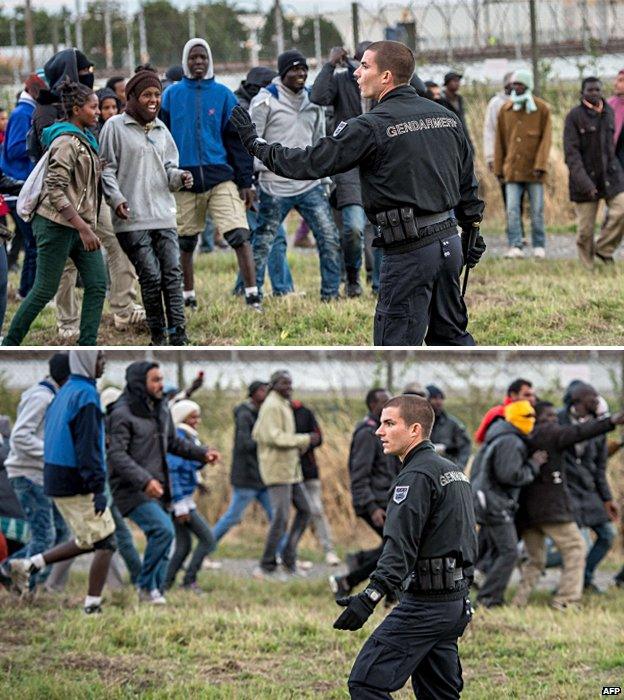
French authorities are also struggling to stop illegal migrants crossing its border from Italy, where more than 60,000 people are thought to have arrived by boat from Africa already this year.

Why is the UK seen as a target?
The situation in Calais is part of a wider migration crisis in Europe - caused largely by the displacement of people from war-torn countries such as Syria, Afghanistan, and Eritrea, and also North Africa.

Many want to claim asylum in the UK. Others want to enter the country incognito to remain as illegal workers.
Natacha Bouchart, Mayor of Calais, has said illegal migrants perceive Britain as a "soft touch" for benefits, and a better place to find jobs in the black economy than France - although studies do not necessarily back up this view.
The British Red Cross said most migrants wanted to make the move because they believed there was a better prospect of finding work in the UK, or because they speak English and want to use the language. Others have relatives in the UK, or are drawn by a belief that there is better housing and education available.
The UK is certainly not alone as a target destination. According to the EU's statistics body Eurostat, external, Germany saw the most non-EU asylum seekers in 2014 - almost 203,000 - followed by Sweden, Italy, France, Hungary, and then the UK.
But the huge influx of migrants into Europe has seen asylum applications soar. Germany - the most popular destination - says it is expecting 800,000 refugees to arrive this year.

Where are the migrants coming from?
The UN High Commissioner for Refugees' representative in France, Philippe Leclerc, said most of the migrants in Calais were fleeing violence in countries such as Syria, Eritrea, Somalia and Afghanistan.

According to data from the UN Refugee Agency, Eritrea topped the list of countries of origin for people seeking and making asylum applications in the UK during the 12 months to the end of March 2015.
The UK and France both have a range of aid programmes in place in an attempt to address the root causes of the migrant crisis.

How many migrants make it to the UK?
The short answer is, no-one knows. Home Secretary Theresa May has conceded that "a number" of migrants do make it across, but has not given specific figures. The Home Office says it has neither official figures or estimates for the number of illegal migrant crossings.
There were 25,020 applications for asylum, external in the year ending March 2015, but the figures are not broken down by point of entry, so there is no way of knowing how many of those people travelled through Dover. A Home Office spokesman said this was for security reasons.
Both Kent Police and Kent County Council also say they do not hold official figures - although the leader of Kent County Council has said its children's social services department is under "enormous strain" because of the number of unaccompanied asylum-seeking children entering the Port of Dover. The county is currently caring for more than 600 under-18s, council leader Paul Carter said.

What is Operation Stack?
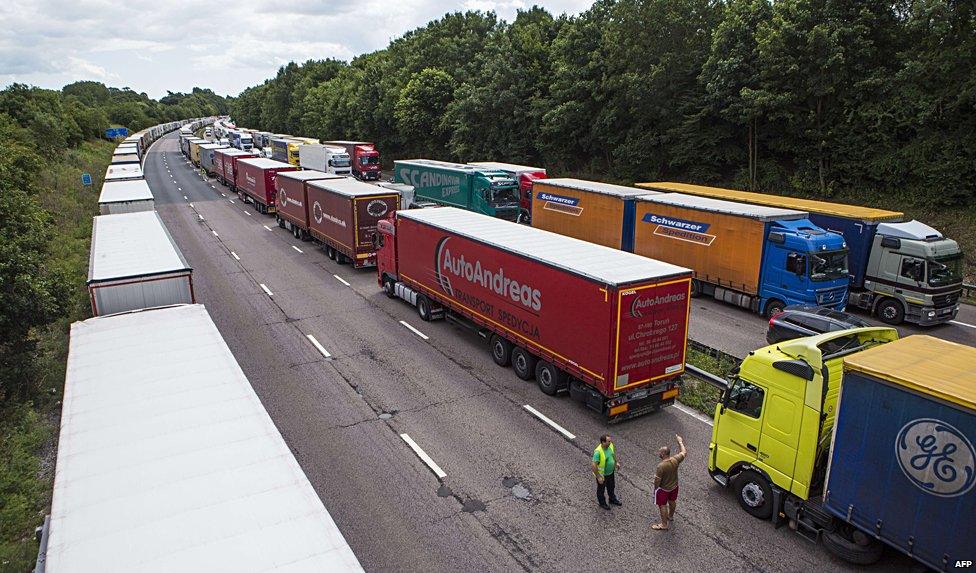
Operation Stack is an emergency procedure used by Kent Police to park freight vehicles on the M20 in Kent - essentially turning it into a giant lorry park.
It has been used since 1996 whenever there is disruption to cross-Channel services, generally as a result of migrant activity, bad weather, or industrial action. The road is closed in three phases, depending on how much space is needed. It can remain closed for days at a time, with thousands of Calais-bound lorries sitting dormant, leading to severe delays in areas of Kent.
Between 1996 and the end of 2007, Operation Stack was implemented 95 times for a total of 145 days. It has been used intermittently since 2007 but rarely for more than a few hours or a day or two at a time. However, June and July of this year saw "unprecedented" use of the tactic, according to the Freight Transport Association (FTA).
In August, the government announced the temporary use of Manston Airfield in east Kent to hold freight lorries, external bound for Dover.